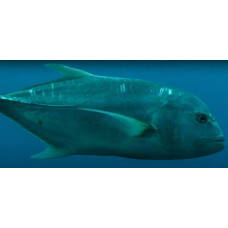Latin name
Caranx ignobilis
Other names
Lowly trevally, barrier trevally, ronin jack, giant kingfish, ulua
Identification
Body elongate, slightly compressed at the sides, covered with small cycloid scales. Thorax without scales. Upper body profile strongly convex in front. Profile of lower body slightly convex. Snout rounded. The tip of the upper jaw reaches to a vertical line passing through the end of the eye. The eyelid is small in the anterior part of the eye and reaches the posterior edge of the pupil in the posterior part of the eye.
The teeth on the upper jaw are arranged in two rows; the front row strong, widely spaced, fang-shaped; the inner row small, tufted. The teeth on the lower jaw are in a single row; strong, conical, widely spaced in adults.
The first gill arc has 20-24 gill stamens, of which 5-7 on the upper part and 15-17 on the lower part. The lateral line forms a high arc in the anterior part and then continues straight to the caudal peduncle. The curved part of the lateral line has 58-64 scales; the straight part has 0-4 scales and 26-38 bony flaps. Vertebrae: 10 trunk vertebrae and 14 tail vertebrae.
Features of fish fins
Two dorsal fins. The first dorsal fin has 8 hard rays and the second has 1 hard ray and 18-21 soft rays. The anal fin has 1 barbed ray and 15-17 soft rays, with 2 barbs in front of the fin. The anterior soft rays of the dorsal and anal fins are elongated. The pectoral fins are elongated, sickle-shaped. Pelvic fins have 1 hard and 19-20 soft rays. Caudal fin sickle-shaped.
Fish colouring
There is a small patch on the chest at the base of the pelvic fins. In individuals less than 50 cm long, the head and body are silvery grey, the back is darker and the belly is silvery. There is no patch on the gill cover. Fins are grey to black, with only the anterior edges and tips of the dorsal and anal fins paler. Sexual dimorphism is observed in large mature individuals. In males the body is greyish black or anthracite black. Some individuals have silvery lines on the back against a black background. Females are silver-grey. There are no spots on the sides of the body. Individuals living in turbid water have yellowish fins.
Distribution
Widespread in the tropical and subtropical waters of the Indo-Pacific. Indian Ocean: from the Red Sea and Persian Gulf along the east coast of Africa to South Africa; along the Asian continent, including Pakistan, India, Southeast Asia, Indonesia and northern and western Australia; and off islands in the Indian Ocean, including the Maldives, Seychelles, Cocos Islands, Madagascar and many small islands. Pacific Ocean: from southern Japan and Hong Kong to Vietnam, eastern Australia and New Zealand; off the islands of Tonga, Pitcairn, Hawaii and the Galapagos Islands.
Habitat
Marine pelagic fish. Adults live in open waters and are tied to a single habitat, which they do not leave for several years, moving up to 9 km within the area.
Size
Maximum body length 170 cm, usually up to 100 cm. Body weight up to 80 kg.
Behavior
Mature individuals are solitary or form small groups. They gather in small schools during the pre-spawning and spawning periods and sometimes form schools during the feeding period. Juveniles and immature individuals are gregarious, with juveniles not forming schools with other fish species and larger individuals feeding with other species of the genus Caranx. Euryhaline enter estuaries and even river mouths to feed, travelling upstream to the tidal zone.
They are most active at dawn and dusk, when the longest movements have been recorded. Seasonal migrations in the Solomon Islands during the spawning season reach 30 km, although no movements between atolls have been recorded.
Food and feeding habits
Predatory fish. It feeds mainly on other fish, with the rest of its diet consisting of various crustaceans, cephalopods and sometimes molluscs.
Reproduction
Spawn in the summer months. There are regional differences in age and size at maturity and in the timing of spawning. In the coastal waters of Hawaii, females first mature at about 60 cm body length at 3-4 years of age. They spawn from April to November with a peak from May to August. Off the east coast of Africa (between 1°S and 10°S), they first mature at 54-61 cm body length and 3-5 kg body weight. Females with mature gonads have been observed from July to March, with spawning peaking from November to March. Underwater observations in the Philippines have shown that spawning peaks in December and January, with a second peak in June. It should also be noted that the spawning season of Giant trevally is quite long and spawning may be batch spawning.
Fishing
Very important in modern fisheries. Commercially, this fish is caught in a variety of ways, including hook and line, hand lines, gill nets and other types of artisanal traps.
Relationship with a person
The fish is of excellent quality, with white dense flesh. There have been reports of ciguatera poisoning.
Attacks on humans have been recorded, with a giant trevally ramming a diver.
| Classification | |
| Phylum | Chordata |
| Class | Actinopterygii |
| Squad | Carangiformes |
| Family | Carangidae |
| Genus | Caranx |
| Species | C. ignobilis |
| Features | |
| Conservation status | Least Concern |
| Habitat | Pelagic |
| Life span, years | No information |
| Maximum body weight, kg | 80 |
| Maximum length, cm | 170 |
| Sailing speed, m/s | No information |
| Threat to people | Edible |
| Way of eating | Predator |
Giant trevally
Tags: giant trevally



